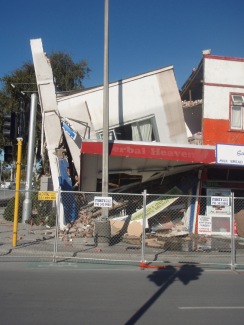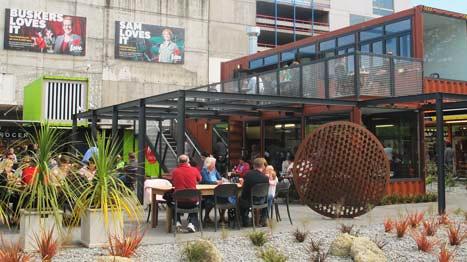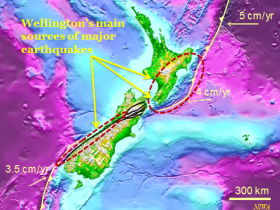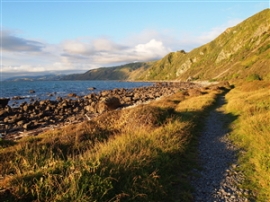- 7 August 2013, First night at Christchurch’s cardboard cathedral – The opening of the new cardboard cathedral was celebrated last night, with the first of 10 performances by the Christchurch City Choir,as part of the Joyfully Un-Munted Festival. The $5.3 million temporary cathedral can host 700 people and has been built to last 50 years.
- 29 July 2013, Emergency architecture – Christchurch’s cardboard cathedral – The Cardboard Cathedral is a significant rebuild project for the CBD, and as the name suggests, the structure is substantially cardboard – a world first. The Transitional Cathedral temporarily replaces the original badly damaged Cathedral in Latimer Square.
- 26 July 2013, Court of Appeal rules on Cathedral’s fate – TVNZ news story on the Court’s decision to allow the iconic cathedral to be demolished and rebuilt, without obligation to replicate the original.
- 21 July 2013, Two severe earthquakes strike central New Zealand – damage to Wellington and Eastern Marlborough
- 1 March 2013, Christchurch Urban Village Project finalists chosen – The four finalists of the Breathe – Urban Village Project competition were announced in Christchurch last night by Building and Construction Minister Maurice Williamson.Village greens, vege gardens and vibrant laneways are among the features presented by entrants. (The Press – stuff.co.nz)
- 22 February 2013, Canterbury marks two years since quake – Hundreds turn out to the official ceremony in Christchurch, marking the second anniversary of the February 2011 earthquake (Radio NZ National)
- 22 February 2013, Live – Christchurch quake second anniversary – Photo gallery: Two years on from Christchurch’s disastrous earthquake, remembering those lost and looking to the future (stuff.co.nz)
- 1 February 2013, Wellingtonians invited to briefing on policy changes around earthquake prone buildings – 5th February meeting at Michael Fowler Centre. Public consultation on the Government’s proposed changes closes 8 March. Submissions to dbh.govt.nz
- 24 January 2013, Earthquake prone building threshold should remain at current level – says Wellington Chamber of Commerce (wecc.org.nz)
- 20 December 2012, Zoning decision appeal lost – Minister Brownlee acted unlawfully in use of powers when he should have ‘reasonably considered alternatives’ – ruling upheld by Court of Appeal (nzherald.co.nz)
- 13 November 2012, Kapiti and Hutt out in front on emergency preparedness (stuff.co.nz)
- 11 November 2012, Most of 158 buildings unlikely to be in CTV league – Govt (radionz.co.nz)
- 11 November 2012, EQC welcomes admission of false insurance claims (radionz.co.nz)
- 10 November 2012, Christchurch earthquake archive of news and images from NZ Herald (nzherald.co.nz)
- 8 November 2012, Red-zone clearance to accelerate next year (stuff.co.nz)
- 4 November 2012, Archbishop of Canterbury stunned by Christchurch damage (nzherald.co.nz)
- 4 September 2012, Being the best at preparing for the worst (stuff.co.nz)
- 1 August 2012, Christchurch Press – Christchurch businesses forced out of the central city after the February 2011 earthquake are queuing up to return. Several key tenants, including law firm Duncan Cotterill with 120 staff, have said they are keen to shift their workforces back as new office space becomes available.
- 30 July 2012, Stuff – Rebuild plan for Christchurch unveiled
- 20 July 2012, Wellington City Council News – a collaborative project is underway, which will see architecture students from Victoria University come up with design concepts for the seismic upgrade of buildings on Cuba Street. Wellington City Council and the New Zealand Historic Places Trust are supporting the project.
- 14 June 2012, Radio NZ National – The Earthquake Commission (EQC) has secured another year of reinsurance cover, for all of New Zealand, with a 50% higher price tag, a smaller increase than the last. Reinsurance is a major issue for the commission, as it is for private insurers. The fund was at $6 billion before the Canterbury earthquakes, and with costs estimated to reach $12.5 billion, there is a shortfall to deal with. Insurance covers most of this, while taxpayers will contribute close to $1.5 billion. New Zealand is unique in its coverage of land value. Hear EQC boss Ian Simpson talking with Kathryn Ryan on Nine to Noon
- April 30 2012, CERA News – three months extension for Red zone property owners – update from Roger Sutton. With some 4200 people having accepted the Crown offer, the Government and CERA are offering an extension to assist those who have yet to decide on which of the two options is best for their situation. Option 1 has the Crown purchase the property based on the most recent rating valuation for land, buildings and fixtures, taking over all insurance claims for damage. In Option 2, the Crown buys the property at its most recent land rating valuation, thus taking over the EQC claim for land damage only – property owners will need to deal with EQC and their private insurer to settle claims for damage to their buildings and fixtures
- March 30 2012, EQC News – On a global scale, what we’re doing is right up there. Hurricane Katrina in the United States in 2005 was the costliest natural disasters in history, resulting in roughly the same number of insurance claims as the number we have received from our customers. – EQC Chief Exec Ian Simpson commenting on the news that $3 billion has been paid out to claimants, of a total $12 billion liability (690,000 claims) – making the Canterbury EQ the second costliest insured disaster in history, close on the heels of Hurricane Katrina
- March 23 2012, CERA News – more homes in red zone – 251 Avon river border properties re-zoned from orange to red
- March 23 2012, My Property updated – search your address to find the land zone and technical category that applies to your Canterbury property
- March 22 2012, Ziln TV News – NZ Herald – Earthquake Recovery Minister Gerry Brownlee and Labour MP/affected Christchurch Resident Lianne Dalziel – supplementary questions on red zone decisions
- March 2 2012, Business Day – Christchurch CBD red zone – more time needed
- March 2 2012, Stuff – Christ Church Cathedral’s fate decided
- February 17 2012, Stuff – a council report into Wellington’s resilience finds the city’s economy would take a near $40 billion hit, should it suffer an event like the Christchurch earthquake. Some key businesses and services – including government – may vacate Wellington permanently. Costs to strengthen private un-reinforced buildings to comply with the building code (and create a safer city) are estimated at half a billion dollars. Read more
- February 17 2012, CERA News – Riccarton Road building under cordon, as structural integrity is investigated.
- February 10 2012, CERA News – Residential zoning changes announced by Canterbury Earthquake Recovery Minister. Gerry Brownlee – “CERA progress is nothing short of commendable.” Cera’s Roger Sutton – “Positive things going on in the community” – “like Gapfiller’s bicycle-powered cinema” (see cinema cycle-power in action on YouTube)…Brownlee suggested he’s “coming back for the slow-motion films…” Also, insurance workshops are up and running and “universally useful.” See the briefing on YouTube CERA media briefing 10 February – Roger Sutton and Gerry Brownlee
- February 4 2012, Radio NZ News – The official death toll of the February earthquake has risen to 184, after a ruling by the Chief Coroner that the deaths of three elderly women were the result of complications from quake injuries.
- February 4 2012, Radio NZ News – Two new grants from Red Cross, for people still being affected by the Christchurch quakes.
- February 4 2012, The Press “Police investigate Bexley burglaries” – Thieves have targeted chattels in red-zoned homes being demolished.
- February 1 2012, Rebuild Christchurch – Christchurch company, Fabrum Solutions, has secured a major international contract to supply parts for a drilling product designed in Timaru.
- January 27 2012, CERA News “Cantabrians are reminded to have their say on how they want to rebuild Christchurch’s city centre” – Property and business owners, tenants and customers can give CERA their feedback online at www.centralcitystudy.org.nz. The survey aims to capture property owners’ and users’ intentions so CERA can help government and Council to action the Draft Christchurch Central City Plan. Survey results are to be presented to CERA in February.
- January 19 2012, NZ Herald “Coke puts $29m into quake-hit Christchurch” Coca-Cola Amatil, stationery firmOfficeMax and SOE Meridian Energy – all making significant investments in the city since the quakes.
- January 15 2012, Stuff “Quakes push up estuary bed” – Overall, the bed has risen by 14cm, shrinking the area of the estuary covered by water by around 50 hectares”
- January 15 2012, The Press “Disrupted sleep anyone?” – The fourth 5.0 plus magnitude quake to shake ChCh this year – no reports of damage or injury
- January 13 2012, Stuff “Christchurch City pupils achieve best NCEA results”
- January 13 2012, The Star – Canterbury “Cera’s CEO Roger Sutton talks about the recent swarm of aftershocks and responds to some (outside) commentators”
- January 11 2012, Rebuild Christchurch “New grant for Canterbury businesses” Posted by RecoverCanterbury
- January 11 2012, Stuff “Christchurch, one of NZ’s most exciting cities – Lonely Planet” What to do in Christchurch? – your post-quake guide
- January 10 2012, Healthy Christchurch “22 February 2012 Commemorative events now confirmed”
- December 31 2011, Geonet “NZ Earthquake Report – Magnitude 4.8, Saturday, December 31 2011 at 1:44 pm (NZDT), 10 km east of Christchurch”
- December 24 2011, Rebuild Christchurch “Rebuild Christchurch – Civil Defence Update Number 6” Posted in CERA/Govt , Christchurch City Council, Recent Quakes
- December 21 2011, www.cera.govt.nz/support-and-assistance “Information on Support Services – ranging from counselling services to assistance with temporary accommodation for those whose homes are not currently habitable”
- December 21 2011, CERA “Update from Roger Sutton, Chief Executive”
- December 3 2011, Herald Sun “Wellington, South Island rocked by quake” (heraldsun.com.au)
- November 28 2011, Foreign Policy “16 Global Cities to Watch: From Singapore to Christchurch, the urban centers that are shaping the next century” – Photo essay rating Christchurch as a city with “a unique opportunity to rethink urban form”
- October 23 2011, The CEISMIC Project “Digital archive of people’s earthquake experiences officially launched”
- October 19 2011, Stuff “Just 45 minutes away from Armageddon – Allan Freeth”
- October 18 2011, Stuff “Rotary Forum – Bollard says Wellington can learn from Canterbury quakes”
- December 15 2011, NZ Herald “Building up to another construction boom”
- October 19 2011, NZ Herald “Bollard highlights costs of safety”
- October 18 2011, Businessweek “NZ quake rebuild to stoke growth, inflation – Alan Bollard”
- October 10 2011, Scoop “Seismic risk raises major questions for Wellington – Rotary and VUW hosting seismic risk conference”
- June 6 2011, Wellington City Council News “Civil Defence Volunteers numbers swell” – 53 civil defence volunteers graduate in Wellington Wednesday 8 June. Mayor – Wellington vastly better prepared than a year ago
- March 4 2011, Scoop “Press Release – Rotary helps earthquake victims in Christchurch”
- February 23 2011, Stuff “Christchurch Quake (Feb 22) – first images”
Canterbury Earthquake – good information here:
One Stop Shock – Earthquake recovery information sheet (PDF) from the good folk at healthychristchurch.org.nz. Print it and keep handy.
Christchurch Earthquake (archive – no longer updated)
Rebuild Christchurch News Archive (regularly updated)
CERA News (Canterbury Earthquake Recovery Authority)
Civil Defence (New Zealand Ministry of Civil Defence & Emergency Management www.civildefence.govt.nz)
For information on grants go to www.redcrosseqgrants.org.nz
Applications for the Independent Advice for Small Business grant (announced 11 Jan 2012) are available through Recover Canterbury. A business wanting to apply for the grant can contact Recover Canterbury on 0800 50 50 96 or at www.recovercanterbury.co.nz.
Government Hotline for emergency assistance: 0800 779 997
For local emergencies: 111
Canterbury Earthquake Temporary Accommodation Service (CETAS): 0800 6732 27
Christchurch City Council customer services: 03 941 8999 – for help with essential council services like as water supply and sewage disposal.
Earthquake Commission (EQC): 0800 DAMAGE (0800 326 243)
For information on EQC’s insurance cover, cleaning up and making a claim.
Links
- http://www.showusyourlongdrop.co.nz/ (creative loos!)
- http://robynmmoore.com/christchurch-earthquake-the-day-the-water-stopped-video/ (inspiring short video shot with the help of Auckland Museum and featuring a bunch of awesome Christchurch kids)
- http://drquigs.com/ (Dr Mark Quigley’s plain-English guide to understanding the Canterbury earthquake sequence, with a link to his journal articles on the subject. Mark is Senior Lecturer in Active Tectonics and Geomorphology in the Department of Geological Sciences at the University of Canterbury, New Zealand)











You must be logged in to post a comment.